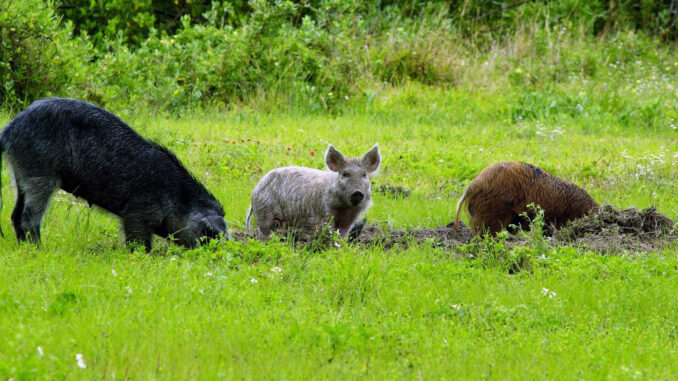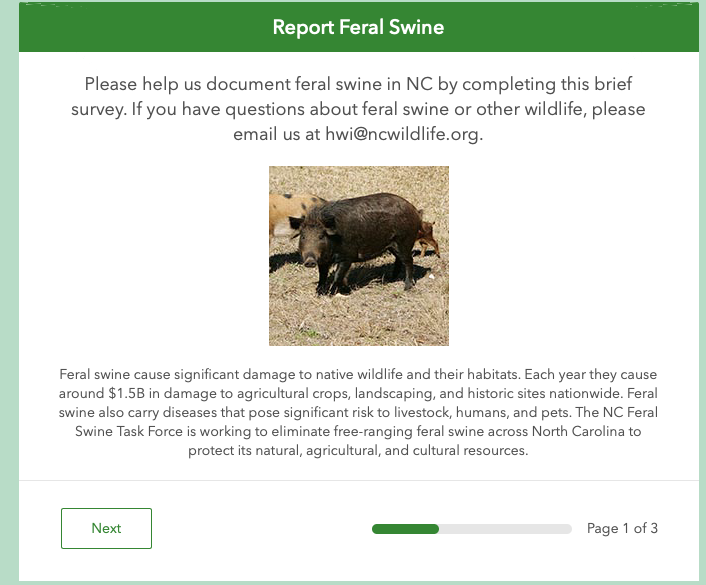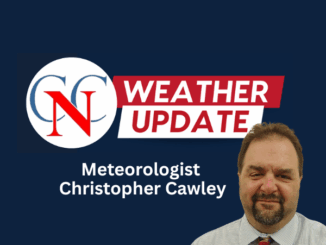
In addition to electronic calls, nighthunting, dogs and bait, hunters have another tool to use in hoghunting– technology.
The N.C. Wildlife Resources Commission has unveiled a new online reporting tool for people to report any sightings of feral swine or damage to the agency. The survey can be found at ncwildlife.org on the feral swine page.

Feral swine, also called wild boar and feral hogs, are an invasive species that cause significant damage to plant communities and wildlife habitat, prey on native wildlife, compete with native species for limited food and clean water resources and potentially spread diseases that pose substantial risk to livestock, wildlife, humans and pets.
Commission biologists, along with other members of the N.C. Feral Swine Task Force, are seeking information from the public to better understand the distribution and abundance of feral swine across the state, and to estimate type and extent of damages they are causing, including damage to agricultural crops, timber, wildlife habitats, landscaping and others.
Reported sightings will help members of the task force determine priority areas where they can focus management efforts. Education and outreach events, technical assistance staff, loaner traps, and other control measures will be focused in areas of greatest need.
“Reports we receive from the public will be extremely important for developing a baseline of information, which we will then use to track how feral swine move across the landscape,” said Falyn Owens, the Commission’s extension biologist. “Changes in the reports we receive over time will also provide a measure of effectiveness of feral swine control efforts across the state.”
Feral swine are highly adaptable animals that can live in urban, suburban and rural areas from the mountains to the sea. In North Carolina, they are typically found in isolated pockets, and have been reported in most counties of the state. Commission biologists hope that citizen reports will help them better assess the extent that feral swine are impacting the states natural resources.
In Columbus county, hogs have displaced deer in many areas around the Waccamaw River. Feral swine are also reportedly moving up the river toward the sensitive ecosystems around Lake Waccamaw State Park. They root cemeteries in Nakina, Old Dock and Crusoe, and destroy crops around Tabor and Clarendon. Rodney Register has become known as the “Hawg Eradicator” for his efforts to trap pigs across the county over the past two years. He expects to top the 300 mark this fall.
Opportunistic feeders and omnivorous, feral swine will eat almost anything, include a wide range of vegetative matter. While foraging, feral swine root into and turn up the soil, causing extensive damage to landscaping, stream banks, lawns, and agricultural fields. On agricultural and developed lands, they cause an estimated $1.5 billion per year in damages to crops across the United States.
While feral swine eat a wide range of vegetation, they also eat snakes, turtles, lizards, the eggs and young of ground nesting birds like quail and turkey, and white-tailed deer fawns.
Feral swine have the potential to carry at least 30 diseases and nearly 40 different parasites that can affect humans, pets, livestock and other wildlife. Diseases like brucellosis, pseudorabies, foot and mouth disease, and African swine fever are just some of the concerns when feral swine and people or livestock interact.
“Simply put, feral swine are invasive and undesirable as free-ranging animals on North Carolina’s landscape,” Owens said. “Unfortunately, illegal releases continue to supplement the growing population, making control of these destructive animals challenging.
“In order to direct resources that will allow landowners and managers to better control feral swine populations and reduce the damages they cause to North Carolina citizens, the natural environment and our native wildlife, we need the public to report sightings to us.”
The N.C. Feral Swine Task Force comprises state and federal agencies that are working collaboratively to learn more about and manage the impacts of feral swine in the state. In addition to the Commission, current members include USDA-Wildlife Services, N.C. Department of Agriculture and Consumer Services, Natural Resource Conservation Service, NCSU Cooperative Extension Service, USDA-Veterinary Services, N.C. Association of Soil and Water Conservation Districts and N.C. Department of Health and Human Services.
For more information on feral swine in North Carolina, visit the Commission’s feral swine web page.





















